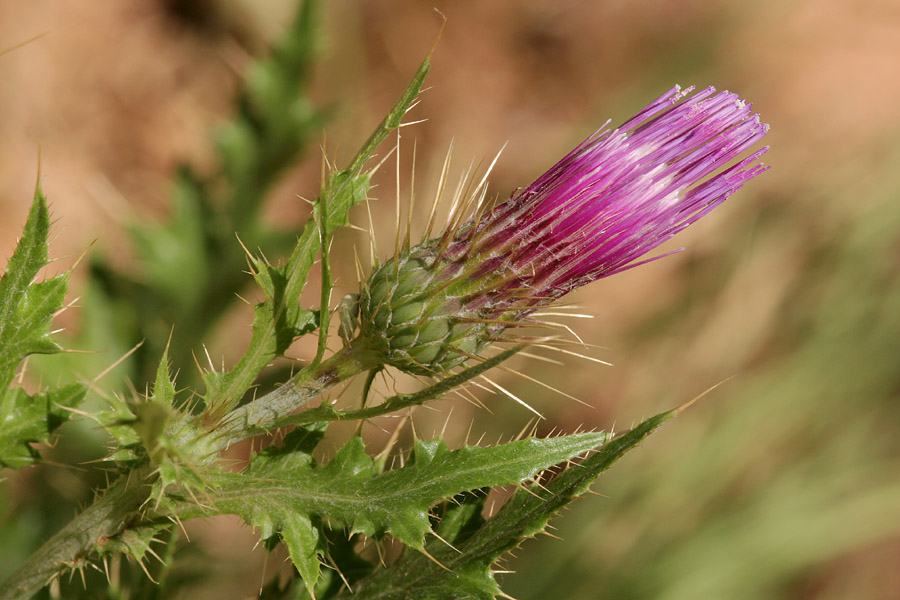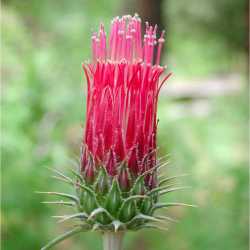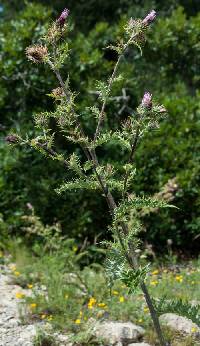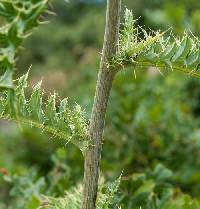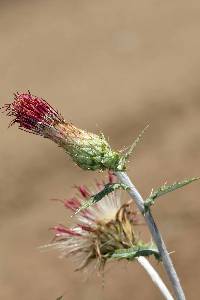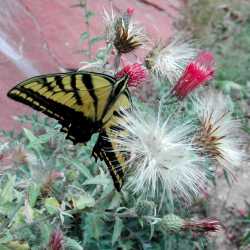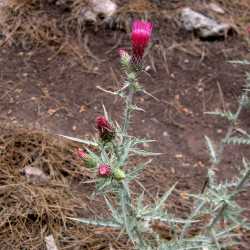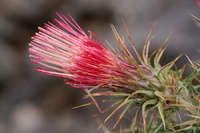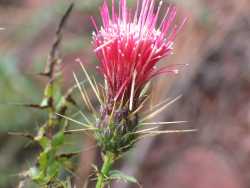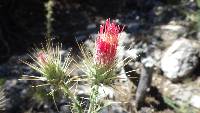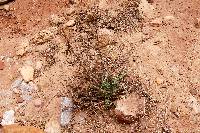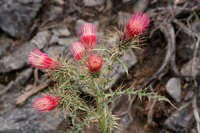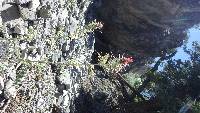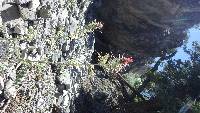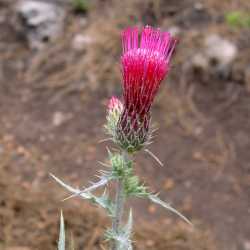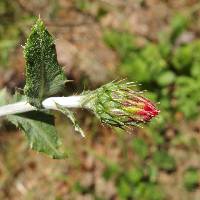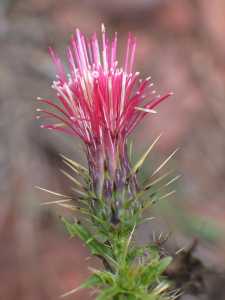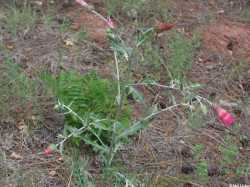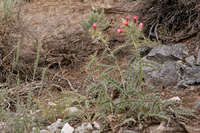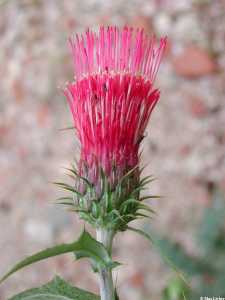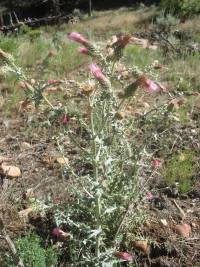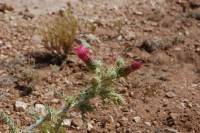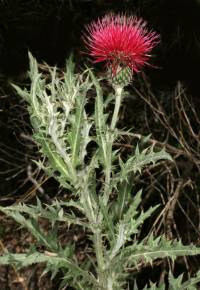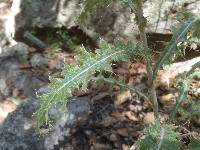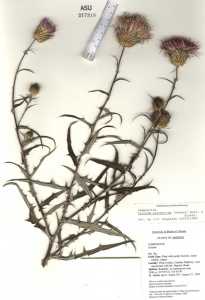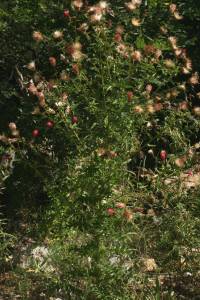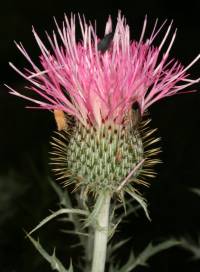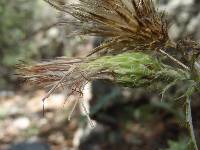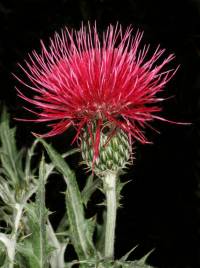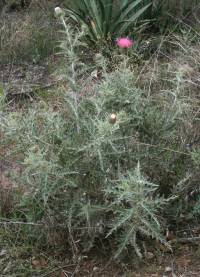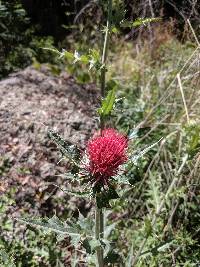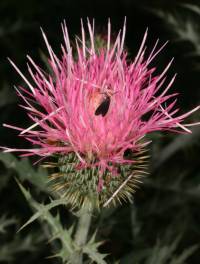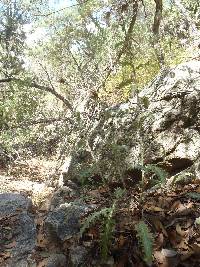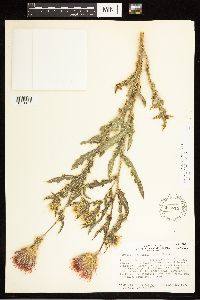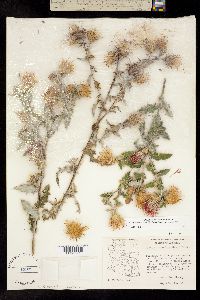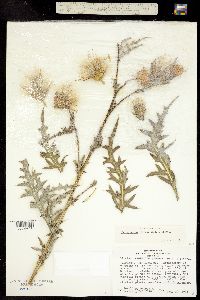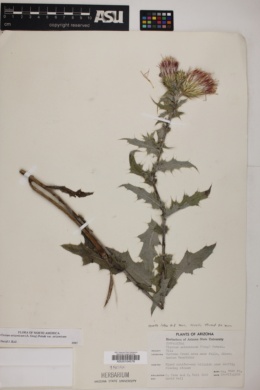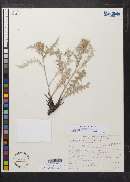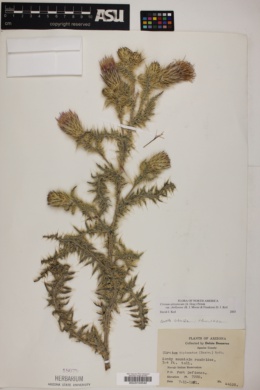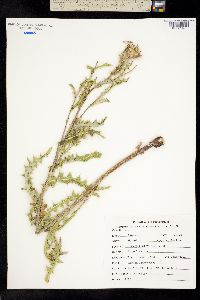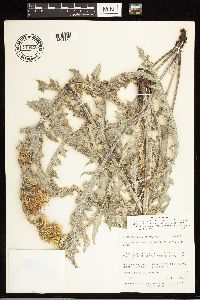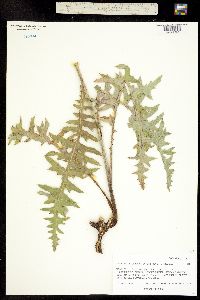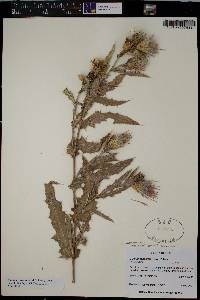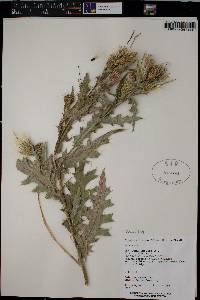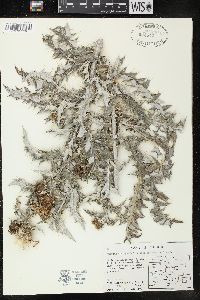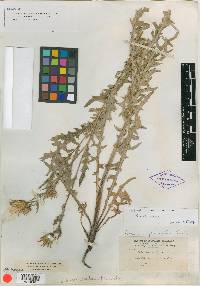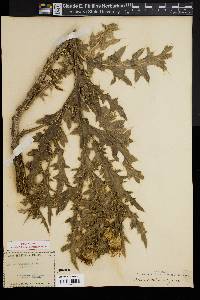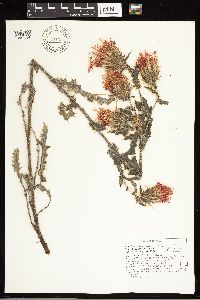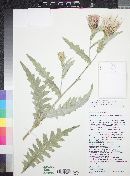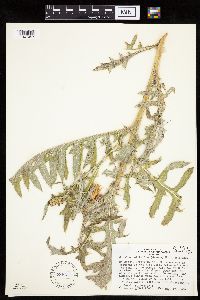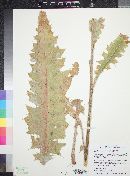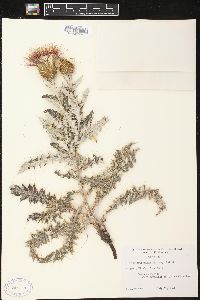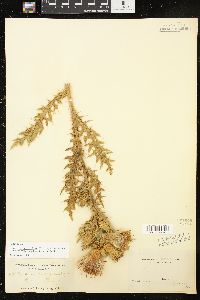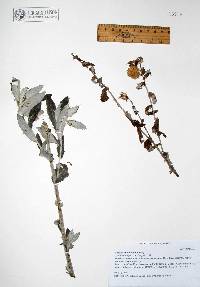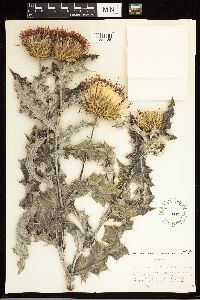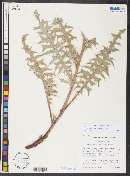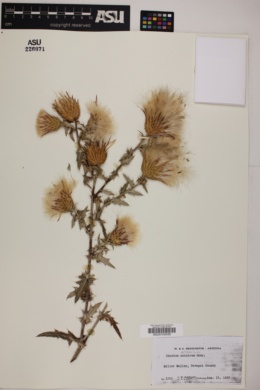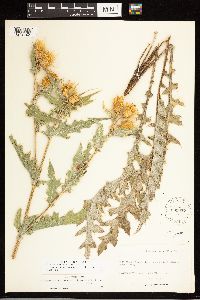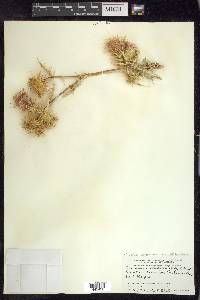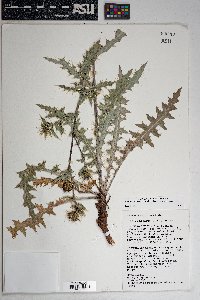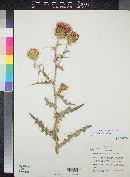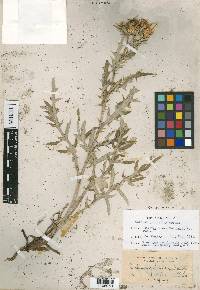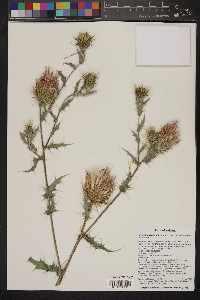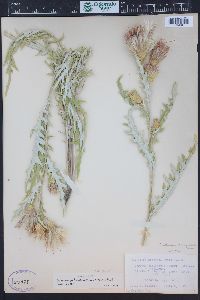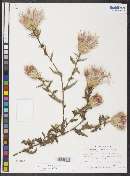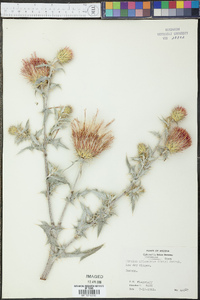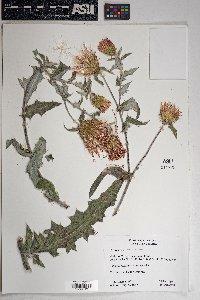
|
|
|
|
Family: Asteraceae
Arizona Thistle, more... (es: cardo santo)
|
Perennials, 30-150 cm; taprooted caudices or runner roots. Stems 1-several, erect or ascending, glabrous to thinly arachnoid-tomentose with fine non-septate trichomes and/or villous with septate trichomes, sometimes ± glabrate; branches 0-many, ascending. Leaves: blades oblong-elliptic, 3-40 × 1-13 cm, unlobed and spinulose to shallowly lobed or divided nearly to midvein, lobes few-many, ovate to linear-acuminate, often again lobed or divided, main spines 2-30 mm, abaxial faces green, glabrous to densely gray tomentose, sometimes midveins villous with septate trichomes, adaxial green, glabrous to gray-tomentose, sometimes glabrate; basal sometimes present at flowering, unlobed to deeply spiny-lobed, winged-petiolate or sessile; principal cauline sessile, well distributed, gradually diminished distally, bases sometimes decurrent as spiny wings to 2.5 cm or clasping; distalmost sometimes ± bractlike. Heads 1-100+, erect, in corymbiform or paniculiform arrays. Peduncles 0-15 cm. Involucres cylindric or ovoid to campanulate, 1.5-4 × 1-2.5 cm (body), loosely arachnoid or ± glabrous. Phyllaries in 7-9 series, imbricate, green or the inner reddish to rich reddish purple, ovate or lanceolate (outer) to linear (inner), margins of outer entire, abaxial faces often with narrow, inconspicuous glutinous ridge; outer and mid bodies appressed, short, entire, apices spreading to ascending, inconspicuous to long, narrow, entire or minutely ciliolate, spines erect to reflexed (outer) to ascending (inner), slender to stout, cylindric or basally flattened, 1-30 mm; apices of inner unarmed or with straight or flexuous spines, short, flat. Corollas pink to red, lavender, or purple (white), 25-31 mm, tubes 7-12.5 mm, throats 1.5-8.5 mm, lobes 10-17 mm; style tips 1-4 mm. Cypselae brown, 3.5-7 mm, apical collars stramineous, 0.2-0.3 mm; pappi 17-28 mm. 2n = 30, 32, 34. The Cirsium arizonicum complex is widely distributed from the Sierra Nevada, White Mountains, and New York Mountains of eastern California across the mountains of the southern Great Basin and Colorado Plateau to the mountains of eastern Colorado, Arizona, and New Mexico. This group of plants comprises a series of intergrading races with intricately overlapping patterns of variation. For plants that I am treating as C. arizonicum (in the broad sense), F. Petrak (1917) recognized three species, one with a variety and two subspecies plus his unstated type subspecies and variety. R. J. Moore and C. Frankton (1974b) revised the complex, recognizing six species, three of them newly described, for the plants I treat as C. arizonicum plus C. turneri, which I do not include in C. arizonicum. P. L. Barlow-Irick (2002), in a work focused on statistical analyses of variation patterns, recognized six species also, but circumscribed very differently from those of Moore and Frankton. Two of the species proposed by Barlow-Irick have not been formally described. I have wrestled with how to treat these plants since beginning my research for this treatment. After careful consideration of the complex patterns of variation among members of the C. arizonicum complex, I acknowledged the futility of trying to distinguish more than one species. Any character combinations that I or others have attempted to use to distinguish species break down hopelessly when enough specimens are examined. Instead I have chosen to recognize that in this complex, as in several others, the plants in question are a work of evolution in progress. Cirsium arizonicum is a rapidly evolving, only partially differentiated assemblage of races that have not reached the level of stability that is usually associated with the concept of species. Certainly there is much variation within the group that deserves a level of taxonomic recognition, or at least should be mentioned, but I think it much more prudent to recognize varieties-entities that may be expected to freely intergrade-rather than species. The geographic area where these plants occur, the highlands of the American Southwest, has had a turbulent history in the Quaternary with major shifts in climate, vegetation, and elevational zonation accompanying the vicissitudes of glacial and interglacial episodes. The complicated patterns of variation in C. arizonicum reflect both that history and t FNA 2006, Kearney and Peebles 1969, McDougall 1973, Heil et al 2013, Allred 2012 Duration: Perennial Nativity: Native Lifeform: Forb/Herb General: Biennial or perennial herbs, 30-150 cm tall, from a taprooted caudex or runner roots; stems wooly to cobwebby, erect, branching; leaves and involucres conspicuously spiny or prickly. Leaves: Basal leaves sessile or on winged petioles, sometimes withering before flowering; cauline leaves alternate, sessile, gradually reduced in size distally; blades narrowly oblong, 3-40 cm long, deeply and irregularly lobed, the lobes often lobed again or with toothy, spiny margins; surfaces green, glabrous to gray-tomentose, the lower leaf surface often more persistently tomentose than the upper surface. Flowers: Flower heads discoid, at branch tips in few-headed panicles; involucre (ring of bracts wrapped around the flower head) broad, cylyndric to campanulate, 1.5-4 cm high, the bracts (phyllaries) spine-tipped, in 7-9 overlapping series; florets all discs, the corollas pink to red, lavender, or purple, or rarely white. Fruits: Achenes brown, smooth, compressed, 6-7 mm long, topped with a pappus of plumose bristles, these up to 2 cm long. Ecology: Found in a variety of upland habitats, from desertscrub, grasslands, juniper woodlands, and openings in conifer forests, from 3,000-12,000 ft (914-3658 m); flowers May-November. Distribution: se CA, s NV, s UT, s CO, AZ, NM. Notes: The name Cirsium arizonicum is applied to a complex of species and varieties which is complicated, intergrading, and not well resolved. The keys to this species are the red to pink or purple flowers, the involucres 3-5 cm high, and the spines of the middle phyllaries short and slender. FNA recognizes 5 varieties, which at one time or another- even in very recent literature- have been recognized as separate species. Var. rothrockii and var. arizonicum both have red to reddish pink flowers, with var. rothrockii found in se AZ and sw NM, and var. arizonicum as a catch-all variety found throughout the species- range. The remaining 3 varieties have flowers that are red-purple to lavender. Var. chellyense is found in ne AZ and nw NM; var. bipinnatum is found throughout the four corners region of AZ, UT, CO, and NM, and south to the Sacramento Mountains in NM; and var. tenuisectum grows in se CA and sw NV. Ethnobotany: Unknown, but other species in the genus have uses. Etymology: Cirsium is Greek for thistle, while arizonicum means of or from for Arizona. Synonyms: Cnicus arizonicus Editor: LCrumbacher 2011, AHazelton 2015 |
|
|
|

